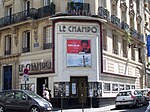Théâtre des Noctambules
Buildings and structures in the 5th arrondissement of ParisFormer buildings and structures in ParisFormer theatres in ParisTheatres in Paris
The Théâtre des Noctambules was a former Parisian cabaret established in 1894 by the chansonnier Martial Boyer (1872–1941) and located at 7 rue Champollion in the 5th arrondissement of Paris (Latin Quarter). In 1939, Pierre Leuris and Jean Claude turned it into a theatre. Fernand Voiturin became manager in 1952 until the venue closed down in June 1956, when the theatre was turned into a Revival house (Art et Essai) under the same name. The Bald Soprano by Eugène Ionesco premiered in this venue in 1950.
Excerpt from the Wikipedia article Théâtre des Noctambules (License: CC BY-SA 3.0, Authors).Théâtre des Noctambules
Rue Champollion, Paris 5th Arrondissement (Paris)
Geographical coordinates (GPS) Address Nearby Places Show on map
Geographical coordinates (GPS)
| Latitude | Longitude |
|---|---|
| N 48.8496 ° | E 2.3429 ° |
Address
Rue Champollion 7
75005 Paris, 5th Arrondissement (Paris)
Ile-de-France, France
Open on Google Maps







